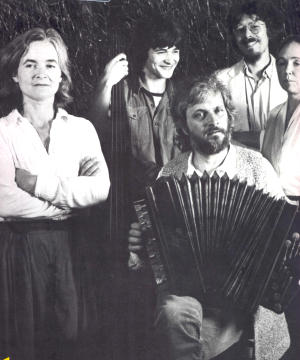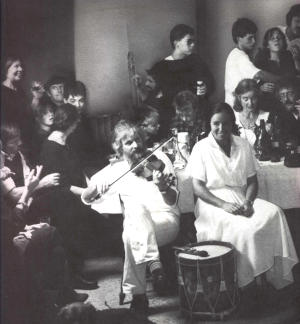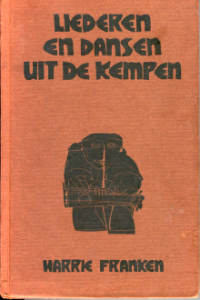FolkWorld
article by Eelco Schilder :
Traditional music from the Netherlands Part VI:
Harrie Franken
 Before
I started this series, I had already drawn up a short list of people I would
like to interview. At the top of my list was Harrie Franken, whom I consider
to be of major importance to traditional music in the southern part of the Netherlands.
Unfortunately, Harrie died last year, which is a great loss to Dutch folk music.
Last February the Dutch magazine Newfolksounds published a story by Hans van
Deelen about Harrie Franken's work. For this article he talked to Peter Koene
(please, read the interview with Peter in
one of the earlier issues) and Hans Hoosemans (of We-nun Henk, a young and very
talented Dutch folk group) about the influence of Harrie's work. Both Hans and
Newfolksounds have kindly permitted me to publish a translated summary of the
article, which gives you the opportunity to get to know Harrie Franken as well.
In my opinion, a series about Dutch traditional music wouldn't be complete without
mentioning him. This article is just a short introduction and doesn't do justice
to the tremendous amount of work Harrie has done. Therefore, I would advise
you to visit the website mentioned at the end of the article as it will give
you a much better idea of the great impact his work has had.
Before
I started this series, I had already drawn up a short list of people I would
like to interview. At the top of my list was Harrie Franken, whom I consider
to be of major importance to traditional music in the southern part of the Netherlands.
Unfortunately, Harrie died last year, which is a great loss to Dutch folk music.
Last February the Dutch magazine Newfolksounds published a story by Hans van
Deelen about Harrie Franken's work. For this article he talked to Peter Koene
(please, read the interview with Peter in
one of the earlier issues) and Hans Hoosemans (of We-nun Henk, a young and very
talented Dutch folk group) about the influence of Harrie's work. Both Hans and
Newfolksounds have kindly permitted me to publish a translated summary of the
article, which gives you the opportunity to get to know Harrie Franken as well.
In my opinion, a series about Dutch traditional music wouldn't be complete without
mentioning him. This article is just a short introduction and doesn't do justice
to the tremendous amount of work Harrie has done. Therefore, I would advise
you to visit the website mentioned at the end of the article as it will give
you a much better idea of the great impact his work has had.
On February 19th 2003 Harrie Franken died. He was an old schoolteacher with
a great interest in traditional songs and tunes. He started playing the violin
at a very young age; later he turned out to be a multi-instrumentalist and vocalist
as well. In 1968 Franken started collecting folk songs from his own region:
the Kempen in South-East Brabant, which is situated in the southern part of
the Netherlands, close to the Belgian border. He visited elderly people and
recorded their songs. After having collected over 2000 different songs he felt
it was time to publish them. In 1973 he founded his own group, so he would be
able to perform the songs he had collected himself. The band was called Ut muziek;
it consisted of members of his family and he was their leader until his death
in 2003. Besides leading Ut muziek, he was also involved with the "Kempische"
folk dance group and he had a weekly column about folk songs on the local radio
station. For this article I spoke with two musicians who have been inspired
by Franken's work: Peter Koene and Hans Hoosemans.
 Peter:
'I met Harrie for the first time around 1980 after he had published his
book with folk songs. I visited him to discuss his material and talk about all
his activities. According to me, his work can be compared to what Herman Dewitt
did in Belgium and I wondered why he had not tried to get attention nationwide.
However, Harrie wanted to keep it all on a small scale and preferred to work
in his own familiar region with the people he knew well. His work was real donkey
work; he searched for songs, copied them and categorised them (developing a
unique computer programme in the process)'
Peter:
'I met Harrie for the first time around 1980 after he had published his
book with folk songs. I visited him to discuss his material and talk about all
his activities. According to me, his work can be compared to what Herman Dewitt
did in Belgium and I wondered why he had not tried to get attention nationwide.
However, Harrie wanted to keep it all on a small scale and preferred to work
in his own familiar region with the people he knew well. His work was real donkey
work; he searched for songs, copied them and categorised them (developing a
unique computer programme in the process)'
Hans: 'Harrie's work is extremely valuable. His songbook Liederen en
dansen uit de Kempen (Songs and dances from the Kempen) is the only one that
contains folk songs from Brabant. In my opinion, this book measures up to the
Flemish standard works by Coussemaeker and Bols. In search of material for the
We-nun Henk cd Bar we went through his book and we actually used three of the
songs on the cd.'
Franken busied himself with every aspect of folk songs for a long time. For
some years the local authorities even enabled him financially to spend more
time on his time-consuming research. Thus, in a period of 35 years he amassed
a tremendous knowledge of folk songs and, in the end, had collected more than
10.000 songs. He published these songs in the aforementioned book and in the
series Kroniek van de Kempen, a collection of articles that had earlier been
published in a local weekly magazine. This Kroniek van de Kempen is a series
consisting of 20 books, containing not only songs but also historical facts
and local stories. Harrie's work was a source of inspiration to many folk groups,
who derived their repertoire from his books. In addition to We-nun Henk, the
well-known Dutch group Dommelvolk also used these books regularly when they
were looking for "new" material.
 Peter:
'The special thing about Harrie was that he recorded literally everything people
sang. This is so different from the way the Dutch archives for folk songs operate,
there people only seem to be interested in songs with a long oral history. Harrie
was interested in everything: songs from the street, political songs, protest
songs etc. So when Jaap Oudesluijs and I had plans for a songbook on the history
of 'ordinary' people we visited Harrie and he told us enthusiastically about
several of his finds. Although nothing ever came of the book, we did use the
material we collected for the Proloog lp De klucht van Pierlala. Apart from
all this, Harry was a person who was deeply involved in social issues. When,
at the beginning of the eighties, the Belgian government was planning to build
a nuclear power plant very close to the Dutch border, he organised many demonstrations
accompanied by lots of music.'
Peter:
'The special thing about Harrie was that he recorded literally everything people
sang. This is so different from the way the Dutch archives for folk songs operate,
there people only seem to be interested in songs with a long oral history. Harrie
was interested in everything: songs from the street, political songs, protest
songs etc. So when Jaap Oudesluijs and I had plans for a songbook on the history
of 'ordinary' people we visited Harrie and he told us enthusiastically about
several of his finds. Although nothing ever came of the book, we did use the
material we collected for the Proloog lp De klucht van Pierlala. Apart from
all this, Harry was a person who was deeply involved in social issues. When,
at the beginning of the eighties, the Belgian government was planning to build
a nuclear power plant very close to the Dutch border, he organised many demonstrations
accompanied by lots of music.'
The foundation that is concerned with putting Harrie Franken's songs into the
archives is called the "Foundation for folksongs from Brabant". This foundation
is run by his wife and son, assisted by a group of people who have a soft spot
for Harrie Franken's work.
Please visit www.volksliedarchief.nl
for more information or to order the cd's.
Informations to the photos:
(1) Harrie Franken with Ut muziek. Picture taken from their lp-sleeve Verhhalende
liederen from 1983 Made by P.v/d Kruis
(2) Harrie Franken with Ut muziek. Picture taken from their lp-sleeve Feestliederen
from 1984 Made by P. v/d Kruis
(3) Harrie Frankens book: 'Liederen en dansen uit de kempen' as published in
1978, first pressing.
DISCOGRAPHY:
- Ut muziek (with Gerard van Maasakkers) Kerst en nieuwjaarsliederen (Xilovox
1982)
- Ut muziek Verhalende liederen (Xilovox 1983)
- Ut muziek Feestliederen (Xilovox 1984)
- Het Kempisch volksorkest Speelt ten dans (Xilovox 1984)
- Het Kempisch volksorkest Dansen (2000)
- Book: Liederen en dansen uit de Kempen parts 1 - 3
The series "Traditional Music in The Netherlands" tries to provide
an overview of Dutch traditional music from both the past and the present, presenting
musicians or groups who represent some of the most important trends or movements
in Dutch folk music. The first four parts of the series were:
Do you have any questions about the article? Do you want more information? Are
you interested in one of the albums mentioned above? Feel free to contact me
any time; also with suggestions for future articles etc or comments on this
article. Eelco Schilder
Back to the content of FolkWorld Features
To the content of FolkWorld No. 28
© The Mollis - Editors
of FolkWorld; Published 04/2004
All material published in FolkWorld is © The
Author via FolkWorld. Storage for private use is allowed and welcome. Reviews
and extracts of up to 200 words may be freely quoted and reproduced, if source
and author are acknowledged. For any other reproduction please ask the Editors
for permission. Although any external links from FolkWorld are chosen with greatest
care, FolkWorld and its editors do not take any responsibility for the content
of the linked external websites.
FolkWorld - Home of European Music

Layout & Idea of FolkWorld © The
Mollis - Editors of FolkWorld
 Before
I started this series, I had already drawn up a short list of people I would
like to interview. At the top of my list was Harrie Franken, whom I consider
to be of major importance to traditional music in the southern part of the Netherlands.
Unfortunately, Harrie died last year, which is a great loss to Dutch folk music.
Last February the Dutch magazine Newfolksounds published a story by Hans van
Deelen about Harrie Franken's work. For this article he talked to Peter Koene
(please, read the interview with Peter in
one of the earlier issues) and Hans Hoosemans (of We-nun Henk, a young and very
talented Dutch folk group) about the influence of Harrie's work. Both Hans and
Newfolksounds have kindly permitted me to publish a translated summary of the
article, which gives you the opportunity to get to know Harrie Franken as well.
In my opinion, a series about Dutch traditional music wouldn't be complete without
mentioning him. This article is just a short introduction and doesn't do justice
to the tremendous amount of work Harrie has done. Therefore, I would advise
you to visit the website mentioned at the end of the article as it will give
you a much better idea of the great impact his work has had.
Before
I started this series, I had already drawn up a short list of people I would
like to interview. At the top of my list was Harrie Franken, whom I consider
to be of major importance to traditional music in the southern part of the Netherlands.
Unfortunately, Harrie died last year, which is a great loss to Dutch folk music.
Last February the Dutch magazine Newfolksounds published a story by Hans van
Deelen about Harrie Franken's work. For this article he talked to Peter Koene
(please, read the interview with Peter in
one of the earlier issues) and Hans Hoosemans (of We-nun Henk, a young and very
talented Dutch folk group) about the influence of Harrie's work. Both Hans and
Newfolksounds have kindly permitted me to publish a translated summary of the
article, which gives you the opportunity to get to know Harrie Franken as well.
In my opinion, a series about Dutch traditional music wouldn't be complete without
mentioning him. This article is just a short introduction and doesn't do justice
to the tremendous amount of work Harrie has done. Therefore, I would advise
you to visit the website mentioned at the end of the article as it will give
you a much better idea of the great impact his work has had.  Peter:
'I met Harrie for the first time around 1980 after he had published his
book with folk songs. I visited him to discuss his material and talk about all
his activities. According to me, his work can be compared to what Herman Dewitt
did in Belgium and I wondered why he had not tried to get attention nationwide.
However, Harrie wanted to keep it all on a small scale and preferred to work
in his own familiar region with the people he knew well. His work was real donkey
work; he searched for songs, copied them and categorised them (developing a
unique computer programme in the process)'
Peter:
'I met Harrie for the first time around 1980 after he had published his
book with folk songs. I visited him to discuss his material and talk about all
his activities. According to me, his work can be compared to what Herman Dewitt
did in Belgium and I wondered why he had not tried to get attention nationwide.
However, Harrie wanted to keep it all on a small scale and preferred to work
in his own familiar region with the people he knew well. His work was real donkey
work; he searched for songs, copied them and categorised them (developing a
unique computer programme in the process)' Peter:
'The special thing about Harrie was that he recorded literally everything people
sang. This is so different from the way the Dutch archives for folk songs operate,
there people only seem to be interested in songs with a long oral history. Harrie
was interested in everything: songs from the street, political songs, protest
songs etc. So when Jaap Oudesluijs and I had plans for a songbook on the history
of 'ordinary' people we visited Harrie and he told us enthusiastically about
several of his finds. Although nothing ever came of the book, we did use the
material we collected for the Proloog lp De klucht van Pierlala. Apart from
all this, Harry was a person who was deeply involved in social issues. When,
at the beginning of the eighties, the Belgian government was planning to build
a nuclear power plant very close to the Dutch border, he organised many demonstrations
accompanied by lots of music.'
Peter:
'The special thing about Harrie was that he recorded literally everything people
sang. This is so different from the way the Dutch archives for folk songs operate,
there people only seem to be interested in songs with a long oral history. Harrie
was interested in everything: songs from the street, political songs, protest
songs etc. So when Jaap Oudesluijs and I had plans for a songbook on the history
of 'ordinary' people we visited Harrie and he told us enthusiastically about
several of his finds. Although nothing ever came of the book, we did use the
material we collected for the Proloog lp De klucht van Pierlala. Apart from
all this, Harry was a person who was deeply involved in social issues. When,
at the beginning of the eighties, the Belgian government was planning to build
a nuclear power plant very close to the Dutch border, he organised many demonstrations
accompanied by lots of music.'